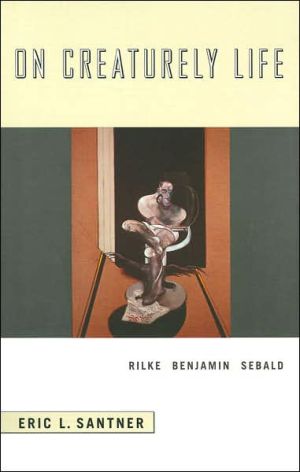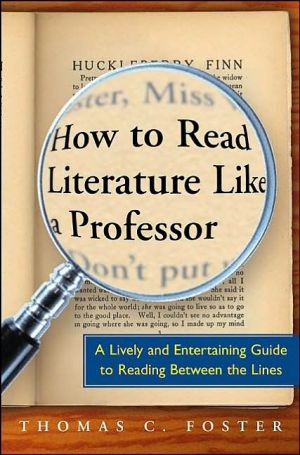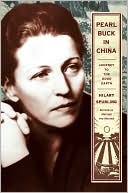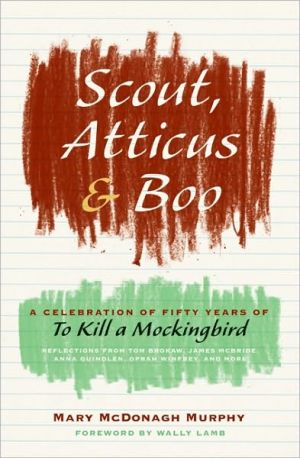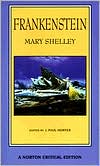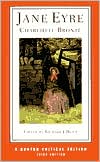On Creaturely Life: Rilke, Benjamin, Sebald
In his Duino Elegies, Rainer Maria Rilke suggests that animals enjoy direct access to a realm of being—the open—concealed from humans by the workings of consciousness and self-consciousness. In his own reading of Rilke, Martin Heidegger reclaims the open as the proper domain of human existence but suggests that human life remains haunted by vestiges of an animal-like relation to its surroundings. Walter Benjamin, in turn, was to show that such vestiges—what Eric Santner calls the...
Search in google:
In his Duino Elegies, Rainer Maria Rilke suggests that animals enjoy direct access to a realm of being—the open—concealed from humans by the workings of consciousness and self-consciousness. In his own reading of Rilke, Martin Heidegger reclaims the open as the proper domain of human existence but suggests that human life remains haunted by vestiges of an animal-like relation to its surroundings. Walter Benjamin, in turn, was to show that such vestiges—what Eric Santner calls the creaturely—have a biopolitical aspect: they are linked to the processes that inscribe life in the realm of power and authority. Santner traces this theme of creaturely life from its poetic and philosophical beginnings in the first half of the twentieth century to the writings of the enigmatic German novelist W. G. Sebald. Sebald’s entire oeuvre, Santner argues, can be seen as an archive of creaturely life. For Sebald, the work on such an archive was inseparable from his understanding of what it means to engage ethically with another person’s history and pain, an engagement that transforms us from indifferent individuals into neighbors. An indispensable book for students of Sebald, On Creaturely Life is also a significant contribution to critical theory.MLR"Santner has many interesting things to say, and works ingeniously to bring this broad range of interests under the single umbrella of the 'creaturely'. . . . A challenging but rewarding attempt to explore the intersection between aesthetic and ethico-political strategies in both Sebald and twentieth-century thought in general."— Ben Hutchinson
On Creaturely Life \ RILKE \| BENJAMIN \| SEBALD\ \ By Eric L. Santner UNIVERSITY OF CHICAGO PRESS \ Copyright © 2006 The University of Chicago\ All right reserved.\ ISBN: 978-0-226-73503-0\ \ \ \ Chapter One \ On Creaturely Life\ I\ In his eighth Duino Elegy, Rainer Maria Rilke famously sets off human life from the way of being of what he calls, simply, die Kreatur. In the elegy, written in 1922, Rilke praises the capacity of plant and animal life to inhabit a seemingly borderless surround that he names, as the environmental correlate or sphere of the creature, das Offene-the Open:\ With all its eyes the natural world [die Kreatur] looks out into the Open.\ Because human life is essentially reflective, mediated through consciousness and self-consciousness, man's relation to things is crossed with borders, articulated within a matrix of representations that position him, qua subject, over against the world, qua object of desire and mastery:\ Only our eyes are turned backward, and surround plant, animal, child like traps, as they emerge into their freedom.\ Even the child, Rilke says, is only fleetingly absorbed by the Open:\ We know what is really out there only from the animal's gaze; for we take the very young child and force it around, so that it sees objects-not the Open, which is so deep in animals' faces.\ At the end of the first strophe, Rilke suggests that it is ultimately death anxiety that disrupts the free movement in the Open for humankind:\ We, only, can see death; the free animal has its decline in back of it, forever, and God in front, and when it moves, it moves already in eternity, like a fountain.\ Man is forever caught up in the labor of the negative-the (essentially defensive) mapping and codification of object domains that allow for certain sorts of desire and possession but never what Rilke posits as the unimaginable enjoyment of self-being in otherness manifest by the creature:\ Never, not for a single day, do we have before us that pure space into which flowers endlessly open. Always there is World and never Nowhere without the No: that pure unseparated element which one breathes without desire and endlessly knows.\ Man, instead, is condemned to the ceaseless production of mediating representations (in German the word for representation, Vorstellen, literally means to place before, in front of, over against the agent of representation):\ That is what fate means: to be opposite [gegenüber sein], to be opposite and nothing else, forever.\ In the second strophe, Rilke indicates that in certain states or phases of human life one might, as it were, make brief contact with the dimension of the Open. Childhood, as was suggested, provides a brief threshold for such contact:\ A child may wander there for hours, through the timeless stillness, may get lost in it and be shaken back.\ But so does death:\ Or someone dies and is it. For, nearing death, one doesn't see death; but stares beyond, perhaps with an animal's vast gaze [mit grosem Tierblick].\ Finally, Rilke singles out lovers, who-were it not for the transitiveness of their love, their anxious clinging to the object of their desire-are the ones best positioned to relinquish that fateful, oppositional posture that inhibits access to the Open:\ Lovers, if the beloved were not there blocking the view, are close to it, and marvel ... As if by some mistake, it opens for them behind each other ... But neither can move past the other, and it changes back to World [Aber über ihn/kommt keiner fort, und wieder wird ihm Welt].\ In the third strophe, Rilke seems to introduce a series of distinctions into the world of the creaturely, suggesting that even there one discovers degrees of purity with respect to the immersion in the Open, that animal life, too, undergoes forms of breaks and ruptures in relation to this dimension. The thought here is that only those creatures that never experience a radical break between the sphere of gestation and the sphere of motility, creatures never distracted by memories of the more tender and intimate communion of the womb, as Rilke puts it, are fully at home in the Open. Thus the otherwise curious celebration of the life of insects:\ Oh bliss of the tiny creature which remains forever inside the womb that was its shelter; joy of the gnat which, still within, leaps up even at its marriage: for everything is womb.\ In stark contrast to such apparently seamless emergence into and absorption by the Open, Rilke's image of the flight of the bat offers a vision of what one is tempted to call a trauma in the realm of creaturely life:\ And how bewildered is any womb-born creature that has to fly. As if terrified and fleeing from itself, it zigzags through the air, the way a crack runs through a teacup. So the bat quivers across the porcelain of evening.\ Be that as it may, the crucial distinction for Rilke remains that between man and the "world" of the creature taken as a whole. The word Rilke uses to summarize his claim about man's alienation from the Open, his claustral enclosure within an inner theater of representations and mediations, comes, not surprisingly, from the stage. The poet suggests, that is, that only man lives his separation from the maternal sphere as a kind of permanent homesickness experienced in the modality of a compulsive stance of spectatorship over against the world:\ And we: spectators, always, everywhere, turned toward the world of objects, never outward. It fills us. We arrange it. It breaks down. We rearrange it, then break down ourselves.\ Rilke's understanding of such a posture seems to continue what Robert Pippin has characterized as a romantic tradition of seeing alienation "wherever one can detect the presence of self-consciousness and reflection ... as if such reflection, a cardinal aspect of modern mindedness, is inherently doubling," that is to say, as if the human mind not only perceived objects but also, by reflection, had a "second-order self-consciousness of one's perceptual state as a new, dual object."\ II\ Martin Heidegger, the twentieth-century philosopher most associated with the analysis and critique of-or perhaps better, diagnosis and therapy for-the spectatorial attitude Rilke identifies with representational thinking, has himself argued that Rilke's elegy is fundamentally implicated in the stance to the world from which the poem ostensibly seeks to gain a distance. He accuses Rilke of participating in a movement of thought that produces "a monstrous humanization of the 'creature,' i.e., the animal, and a corresponding animalization of man," thereby perpetuating the popular biological metaphysics of the end of the nineteenth century that, in the wake of Schopenhauer and Nietzsche, posits the instinctual will of animal life as a primordial and uninhibited ease of movement through the elemental spheres of existence. Because he identifies human life with the capacity for-and curse of-representational thought, "a consciousness of objects ... that is conscious of itself and is reflected onto itself," Rilke is compelled to conflate the ostensible lack of self-consciousness of animal life with freedom. To cite Pippin once more, what Rilke's conception seems to preclude is an understanding of "reflective absorption as an intensification of such absorption, not a thematizing and ultimately theatricalizing distancing." Pippin adds that this sort of "theatricalizing might be said to occur only when something like the normative structure of such mindedness begins to break down, fails to sustain allegiance, becomes a reflected object of inquiry, not a mode of life." I will return to this theme of breakdown and reification in due course; for the moment I would like to note very briefly some further aspects of Heidegger's critical engagement with Rilke's poem.\ As Heidegger sees it, Rilke's "creaturely" understanding of the Open blinds him to the true ontological distinction of human being, one that cannot be captured by the language of consciousness, self-reflection, and subject-object relations. Grounded as it is in a forgetting of the ontological difference between Being and beings, Rilke's understanding of the Open as a locus of unimpeded motility forecloses the possibility of thinking "the free of Being, and it is precisely this free that the 'creature' never sees; for the capacity to see it constitutes what is essentially distinct about man and consequently forms the insurmountable essential boundary between animal and man." As Heidegger continues, "'The open' in the sense of the unceasing advance of beings in the realm of beings [im Sinne des unaufhörlichen Fortgangs des Seienden im Seienden] and 'the open' in the sense of the free of the clearing of Being in distinction from all beings are verbally the same, but in what the words name they are so different that no oppositional formulation could suffice to indicate the gap between them."\ In Heidegger's "postmetaphysical" understanding, the Open is just the historical field of man's understanding of Being, the ultimate locus and archive of which is human speech. Put somewhat differently, only human being stands in a relation to truth understood as unconcealedness, as the emergence into presence of beings in their Being. For Heidegger, only human beings can be said to be "on to" things in a way that is responsive, indeed beholden to, what and how they are-in a way, that is, that necessarily includes the possibility of being right or wrong about them. For Heidegger, then, the essence of human being can be captured neither by a focus on the "mental," on the structure and contents of the human mind, nor by turning to man's animal will or vitality (for Heidegger, will and representation form two sides of the same metaphysical picture of the world). Rather, human life unfolds in an articulated space of possibilities embodied in the forms of life into which one contingently comes to be initiated, the practices that define one's historical community. In this space of possibilities, things show themselves in various ways, as various sorts of entities: as hammers and nails, as nightingales and sunsets, as oil reserves and lumber, as symphonies and poems, as wine and wafer, as lovers, enemies, gods.\ As fundamentally excluded from what he calls the "strife between unconcealedness and concealedness," the animal is, as Heidegger puts it elsewhere, poor in world (weltarm), while man is essentially world-forming (weltbildend); the stone, by contrast, is simply weltlos, without world. It is against this background that Heidegger draws the distinction between animal behavior-his word is sich benehmen-and human comportment-sich verhalten. What Rilke privileges as uninhibited movement within the Open, Heidegger sees as a purely functional and instinctual captivation (Benommenheit) by an environment, as absorption in an Umwelt as opposed to an intentional comportment within the openness of a Welt. That is, after criticizing the picture Rilke inherits from the metaphysical tradition (in its post-Cartesian incarnation), in which man is seen to be somehow enclosed within the dimension of the mental, the mediations of consciousness (and only secondarily related to world), Heidegger is compelled to distinguish man's engaged absorption in a space of possibilities-in a historical form of life or world-from an animal's absorption in its environment. Heidegger is compelled, that is, to make a distinction between two ways of being in the midst of life, two sorts of relations to the otherness of entities, only one of which transpires, as it were, in-or better, as-the Open, the clearing of an understanding of Being:\ The captivation [Benommenheit] of the animal therefore signifies ... having every apprehending [Vernehmen] of something as something withheld from it. And furthermore: in having this withheld from it, the animal is precisely taken by things [hingenommen durch ...]. Thus animal captivation characterizes the specific manner of being in which the animal relates itself to something else even while the possibility is withheld [genommen] from it-or is taken away [benommen] from the animal, as we might also say-of comporting and relating itself to something else as such and such at all, as something present at hand, as a being. And it is precisely because this possibility-apprehending as something that to which it relates-is withheld from it that the animal can find itself so utterly taken by something else.\ As Giorgio Agamben has suggested in his perspicacious commentary on these and related passages, Heidegger's argument forces us to contemplate a mode of openness and exposure that might be characterized as a nonrelation to an opacity: "For the animal, beings are open but not accessible; that is to say, they are open in an inaccessibility and an opacity-that is, in some way, in a nonrelation. This openness without disconcealment distinguishes the animal's poverty in world from the world-forming which characterizes man."\ Because Rilke failed to grasp the true nature of the animal/human divide-the difference between the animal's poverty in world and man's destiny as world-forming-his poetry fails to accede to the status of an event in the history at issue for Heidegger (unlike that of Heidegger's master poet, Hölderlin). Because he lacked the poeticophilosophical resources for imagining human mindedness beyond the frame of rational, representational thinking-the poetic "saying" of such a beyond would have been the "Rilke event"-he was compelled to elevate animal life to the status of superhuman exception (part of Heidegger's argument is that Rilke achieves poetically what Nietzsche achieves philosophically-the passage to the limit of the metaphysical tradition):\ Since Rilke's poetry ... neither experiences nor respects the essential boundary between the mystery [Geheimnis] of the living being (plant and animal) and the mystery of the historical being, i.e., man, his poetical words never attain the true height of a historically foundational decision. It is almost as if in this poetry there is operative an unlimited and groundless humanization of the animal, by which the animal, with respect to the original experience of beings as a whole [des Seienden im Ganzen], is even raised above man and becomes in a certain way a "super-man" [Über-Menschen].\ III\ Agamben's crucial contribution to this "debate" between Rilke and Heidegger as to the meaning of "the Open" in animal and human life has been to underline a profound ambiguity in Heidegger's own position. Agamben points to the ways Heidegger's very insistence on the radical ontological distinction between animal and human life-one conceived, precisely, in opposition to Rilke's still "metaphysical" understanding of the animal/human divide-brings the two kinds of life into an uncanny proximity, one duly noted by Heidegger himself. That is to say, for Heidegger man's freedom and destiny as "world-forming" include a dimension-I am tempted to say a traumatic dimension-that brings him into proximity to the animal, that renders him, in a certain sense, creaturely.\ Interestingly, one of the points at which this proximity begins to register in Heidegger's argument is where he refers to the Pauline conception of a longing for redemption immanent in creaturely life itself, in the haunting vision of creation groaning in travail (Romans 8:18-22). Paul's words suggest to Heidegger that the "animal's poverty in world [is] a problem intrinsic to animality itself." In its captivation by a narrowly delimited functional environment, the animal "finds itself essentially exposed to something other than itself, something that can indeed never be manifest to the animal either as a being or as a non-being." But precisely such exposure, writes Heidegger, "brings an essential disruption [wesenhafte Erschütterung] into the essence of the animal."\ (Continues...)\ \ \ \ \ Excerpted from On Creaturely Life by Eric L. Santner Copyright © 2006 by The University of Chicago. Excerpted by permission.\ All rights reserved. No part of this excerpt may be reproduced or reprinted without permission in writing from the publisher.\ Excerpts are provided by Dial-A-Book Inc. solely for the personal use of visitors to this web site. \ \
Editions of Sebald's works1On creaturely life12The vicissitudes of melancholy433Toward a natural history of the present974On the sexual lives of creatures and other matters143
\ MLR\ - Ben Hutchinson\ "Santner has many interesting things to say, and works ingeniously to bring this broad range of interests under the single umbrella of the 'creaturely'. . . . A challenging but rewarding attempt to explore the intersection between aesthetic and ethico-political strategies in both Sebald and twentieth-century thought in general."\ \ \ \ \ \ Leonardo\ - Eugene Thacker\ On Creaturely Life will likely be read by those who have read Agamben's Homo Sacer and The State of Exception. . . . But I would argue, however, that Santner's book invites a much wider readership. The concerns of the creature presented here open onto other areas of interest, including the extensive and diverse writings on 'animality' and contemporary philosophy's engagement with religion . . . as well as the ways in which contemporary art engages the life sciences."\ \ \ \ German Studies Review\ - Markus Zisselsberger\ "A sustained meditation on the nature of the 'human,' the relationship between life and the political, and the possibility of ethical relations in a posthuman world in which life finds itself subjected to particular forms of violence in the political domain. As such, it will be indispensable reading for both Sebald scholars and those intrerested in contemporary critical theory."\ \ \ \ \ \ MLQ\ - Richard T. Gray\ "An admirable critical accomplishment, [the book] reveals Santner as a master choreographerof ideas central to the tradition of German (not just German-Jewish) modernism."\ \ \ \ \ \ Monatsheft\ - Volker Kaiser\ "A critical masterpiece, which conceives of itself as an ethico-political intervention on the scene of contemporary cultural and literary criticism, a scene that is defined by a complex configuration of diverse material. . . . On Creaturely Life steps on this scene with a fascinating configuration of its own, one that draws upon and draws into proximity a number of famous texts from the German-Jewish tradtion of the first half of the 20th century."\ \ \ \ \ \ MLRSantner has many interesting things to say, and works ingeniously to bring this broad range of interests under the single umbrella of the 'creaturely'. . . . A challenging but rewarding attempt to explore the intersection between aesthetic and ethico-political strategies in both Sebald and twentieth-century thought in general.\ — Ben Hutchinson\ \ \ \ \ \ LeonardoOn Creaturely Life will likely be read by those who have read Agamben's Homo Sacer and The State of Exception. . . . But I would argue, however, that Santner's book invites a much wider readership. The concerns of the creature presented here open onto other areas of interest, including the extensive and diverse writings on 'animality' and contemporary philosophy's engagement with religion . . . as well as the ways in which contemporary art engages the life sciences.\ — Eugene Thacker\ \ \ \ \ \ German Studies ReviewA sustained meditation on the nature of the 'human,' the relationship between life and the political, and the possibility of ethical relations in a posthuman world in which life finds itself subjected to particular forms of violence in the political domain. As such, it will be indispensable reading for both Sebald scholars and those intrerested in contemporary critical theory.\ — Markus Zisselsberger\ \ \ \ \ \ MLQAn admirable critical accomplishment, [the book] reveals Santner as a master choreographerof ideas central to the tradition of German (not just German-Jewish) modernism.\ — Richard T. Gray\ \ \ \ \ \ MonatsheftA critical masterpiece, which conceives of itself as an ethico-political intervention on the scene of contemporary cultural and literary criticism, a scene that is defined by a complex configuration of diverse material. . . . On Creaturely Life steps on this scene with a fascinating configuration of its own, one that draws upon and draws into proximity a number of famous texts from the German-Jewish tradtion of the first half of the 20th century.\ — Volker Kaiser\ \ \
